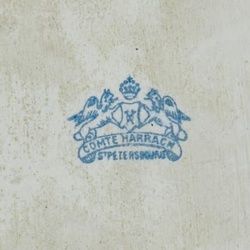
Граф Гаррах (Comte Harrach) и его фарфоровая фабрика.
Немец по происхождению Граф Фердинанд Гаррах отметился в истории фарфора Российской Империи тем, что ввозил качественный европейский фарфор на территорию России или заказывал фарфоровое белье у местных производителей таких как Т-во М.С. Кузнецова, в последствии занимаясь росписью изделий и нанесением его личного клейма. Иногда изделия не клеймились.
Так же граф Гаррах владел стекольным и фарфоровым производством в Чехии. Торговые дома Графа Гарраха по продаже хрустальных и фарфоровых изделий находились в Москве и Санкт-Петербурге.
Граф Гаррах выпускал предметы из фарфора совместно с производителями Франции и Польши, в следствии чего на фарфоровых изделиях ставились несколько марок одновременно.
Так во времена сотрудничества графа Гарраха с широко известным польским фарфоровым заводом Сmelow были выпущены очень интересные фарфоровые столовые и чайные сервизы, отличавшиеся роскошью и высокохудожественным цветочным декором с обилием позолоты. Изделия отличала рельефность фарфоровой поверхности.
Изделия графа Гарраха отличал собственный декор, яркая своеобразная красота ручной росписи или деколи с подрисовкой в соответствии с европейским вкусом того времени, схожая с декором известных марок европейского фарфора такого как Лимож (Limoges).
Фарфоровая мануфактура в польском городе Цмелов (Сmelow) более 200 лет известна как производитель высококачественного фарфора. Марка Cmelow всегда выдерживала конкуренцию с европейскими марками фарфора, поддерживая высокие стандарты качества фарфоровых изделий. Именно французский фарфор всегда служил образцом для фарфорового производства Cmelow.
Фарфоровый завод Cmelow реализовывал престижные заказы аристократии, правительства Польши, различных дипломатов и значимых людей в разные исторические периоды. По оригинальным фасонам в мастерских Cmelow местными художниками расписывались столовые сервизы, чайные и кофейные комплекты, а так же отдельная посуда для свободной компоновки стола. Столовые и чайно-кофейные сервизы фарфорового завода Cmelow покрывались кремовой глазурью. Некоторые предметы изготавливались из цветной голубой и розовой фарфоровой массы. Кроме посуды в разные периоды завод выпускал и декоративную небольшую скульптуру так же интересную для коллекционеров. В настоящее время завод Cmelow продолжает свою работу. Марки фарфоровых изделий Comte Harrach St. Petersburg или Comte Harrach Moscou достаточно редкие для антикварного мира современной России. Под этой маркой встречаются очень выдающиеся изделия с ручной росписью именно из фарфора, являющиеся желанными для большинства коллекционеров и любителей антиквариата ввиду их высокого качества и запоминающегося декора. У графа Гарраха было несколько вариантов клейм: «Comte Harrach St Petrsbourg», «Comte Harrach МOSCOU», они соответствовали расположению его торговых домов в Петербурге и Москве.
1-я мировая война (1914 —1918).
В августе 1914г. Германия, а затем и Австро-Венгрия (родина графа Гарраха) объявили войну России. В стране царили антигерманские настроения. В Петербурге было разгромлено германское посольство, горели представительства немецких фирм, магазины и кафе. Была запрещена немецкая речь. И даже императрица Александра Федоровна, супруга Николая II, не избежала нареканий за свои немецкие корни, население было настроено против нее. Владельцы немецких и австро-венгерских фамилий преследовались, и спешно покидали страну. В итоге в конце августа 1914 г. Николай II переименовал с немецкого (голландского) названия Санкт-Петербург в Петроград «на русский манер». Вследствие этих событий и появилось клеймо «COMTE HARRACH PETROGRAD».







